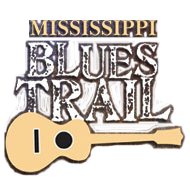W.C. Handy Encounters the Blues
W.C. Handy Encounters the Blues - Tutwiler
Bandleader W. C. Handy was waiting for a train here at the Tutwiler railway station circa 1903 when he heard a man playing slide guitar with a knife and singing “Goin’ where the Southern cross’ the Dog.” Handy later published an adaptation of this song as “Yellow Dog Blues,” and became known as the “Father of the Blues” after he based many of his popular orchestrations on the sounds he heard in the Delta.
Tutwiler has been celebrated as “the birthplace of the blues” in honor of W. C. Handy’s encounter here with a solitary guitarist who was performing one of the earliest documented blues songs. Handy, who led an orchestra in Clarksdale from 1903 to 1905, traveled throughout the Delta and beyond, playing dances for both white and African American audiences, but he began to incorporate blues into his repertoire only after hearing the Tutwiler guitarist and a string band in Cleveland, Mississippi. Although Handy’s writings never gave a specific date for the Tutwiler event, the U. S. Senate accepted 1903 when it declared 2003 the centennial “Year of the Blues.”
In his 1941 autobiography, Father of the Blues, Handy wrote: “A lean, loose-jointed Negro had commenced plunking a guitar beside me while I slept. His clothes were rags; his feet peeped out of his shoes. His face had on it some of the sadness of the ages. As he played, he pressed a knife on the strings of a guitar in a manner popularized by Hawaiian guitarists who used steel bars. The effect was unforgettable. His song, too, struck me instantly. ‘Goin’ where the Southern cross’ the Dog.’ The singer repeated the line three times, accompanying himself on the guitar with the weirdest music I ever heard.” The song referred to the crossing of the Southern and Yazoo & Mississippi Valley railroads in Moorhead, forty-two miles to the south; the Y&MV (sometimes called the Yazoo Delta or Y.D.) was nicknamed the “Dog,” or “Yellow Dog.” After moving to Memphis in 1905, Handy adapted the blues into a series of compositions that helped sparked America’s first blues craze, including “Memphis Blues,” “Yellow Dog Blues,” “Beale Street Blues,” and, most popularly, the classic “St. Louis Blues.” He was already being hailed as the “Daddy of the Blues” by 1919.
Another pivotal figure in blues history, Sonny Boy Williamson No. 2, lies buried two miles northwest of here beside the old Whitfield M. B. Church site. A world-renowned singer, harmonicist, and songwriter, Williamson played a pioneering role in broadcasting the blues on the Helena, Arkansas, radio show, King Biscuit Time. His songs included “Eyesight to the Blind,” “Help Me,” and “Don’t Start Me Talkin’.” Williamson’s influence extended from his bases in the Delta and Chicago to England, where his 1960s tours helped inspire the British blues movement. He died May 25, 1965.
Other former Tutwiler performers include banjo and fiddle player Tom Dumas, whose music harked back to Handy’s era, and pianist-guitarist Lee Kizart. Both were documented by folklorist Bill Ferris here in 1968 and were featured in the 2009 Ferris book Give My Poor Heart Ease.
content © Mississippi Blues Commission
[ BACK TO TOP ]

